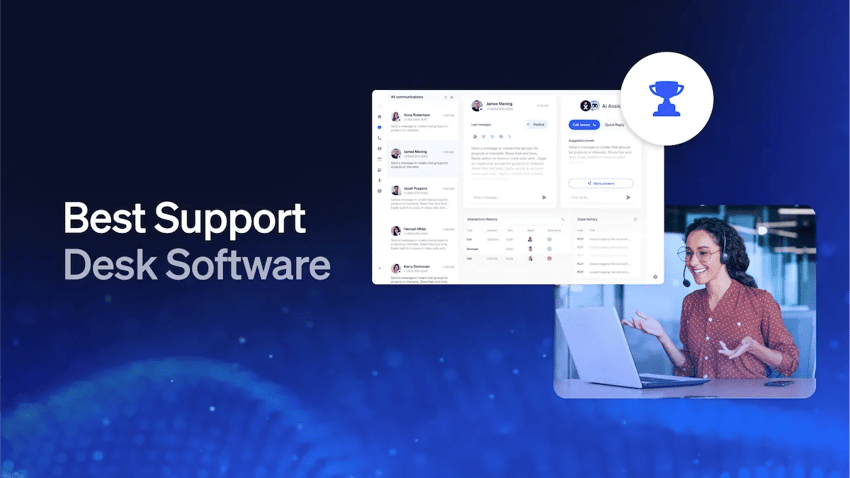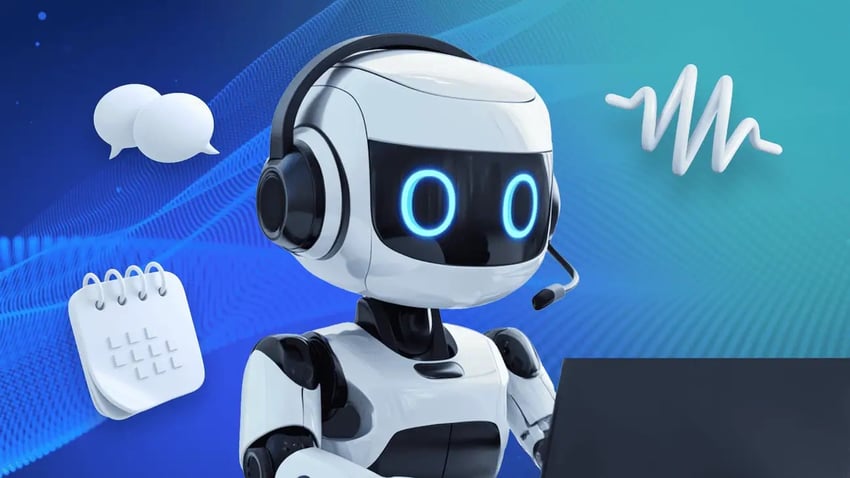When monitoring call center operations, few metrics receive more scrutiny than average handle time (AHT).
Many call centers closely monitor AHT as a key performance indicator (KPI) of agent productivity and efficiency. The push for quick call resolution times is based on simple economics: Shorter calls reduce labor costs and allow more customers or callers to flow through the system.
However, adhering too strictly to AHT goals can also hurt the customer experience.
In this article, we’ll do a quick rundown of AHT to help you understand what this customer service metric means, how to calculate it, and tips for improving it for your call center.
What Is Average Handle Time (AHT)?
Average handle time is basically just average talk time. It refers to the time, measured in minutes and seconds, that call center agents take to handle customer phone calls on average.
AHT is tracked in your call center software and is one of the key metrics and KPIs that call centers use to analyze customer support performance.
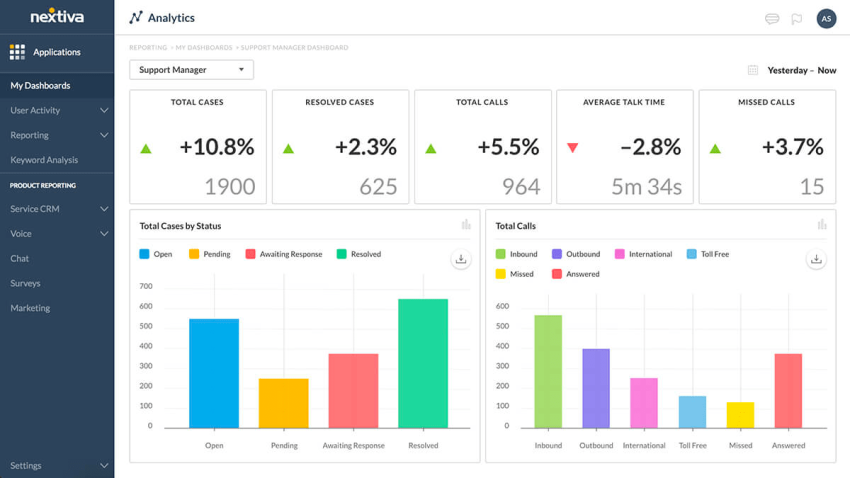
The length of the call is measured starting from when the customer call begins, including hold time, total talk time, and any wrap-up time spent documenting the call after hanging up.
AHT often relates to customer satisfaction and agent performance. In theory, the quicker you resolve a customer’s concern, the happier they will be. But, of course, there’s a significant human impact to factor in here, too.
Average talk time is one important data point that contact centers should track to improve customer experiences. Other metrics include speed of answer, first contact resolution, customer satisfaction score, and Net Promoter Score®.
Remember, your customers will be the happiest if you resolve their concerns on the first contact. A shorter handle time isn’t always better, so don’t try to hurry customers.
Why Is AHT Important?
The average handle time is simple yet an important metric to measure. It plays a crucial part in improving your customer interactions.
If the time customers spend on a support call is longer than they’d like, they form a negative view of your business. In a perfect world, the average handle time is zero — as they’d rather not need to contact you at all.
On this basis, it’s easy to think the lower the AHT, the better. But there’s more in play than just time.
Contact center leaders recognize that the entire customer experience is more valuable than any individual call. So we’ve evolved from asking, “How was this call?” to “How do you view our company?”
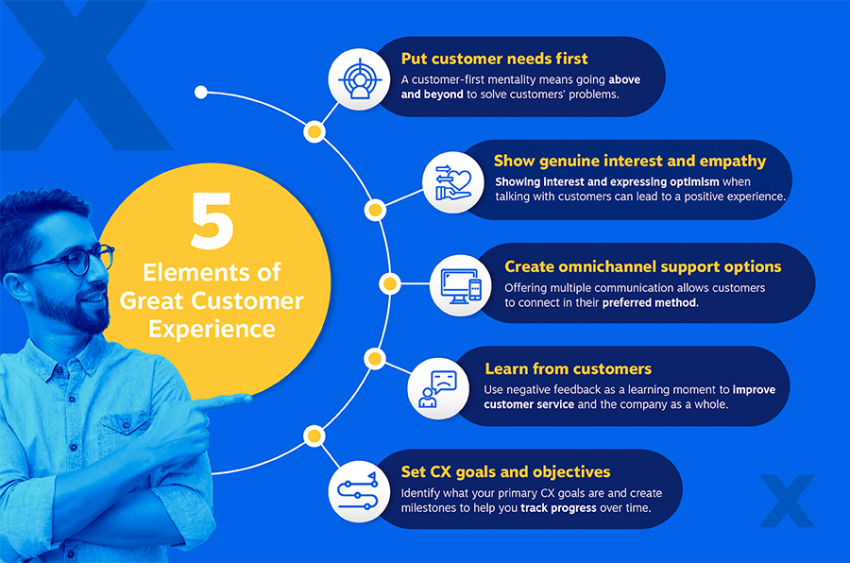
Despite the shift to customer experience, contact center leaders still recognize the importance of AHT. Handle time impacts the total hold time, which influences customer effort and customer satisfaction scores.
Here are some key reasons to measure AHT:
- Agent Productivity: AHT allows call center managers to measure how efficiently agents handle the customer’s issue. This helps optimize labor costs when agents can handle higher volumes.
- Service Level Monitoring: Call centers aim to answer a high percentage of calls within an average duration of 30-60 seconds. Lower AHTs mean calls flow faster through the queue, enabling staff to answer more calls within service-level timeframes.
- Identifying Improvement Areas: Tracking individual and call center-wide AHT metrics over time provides data to analyze patterns. Spikes may indicate that agents need extra training. Consistently high performers showcase best practices that can be replicated.
- Staffing and Capacity Planning: Historical AHT data helps businesses forecast staffing needs and capacity planning. Knowing turnover rates and the average length of calls makes it easier to make sure appropriate agent staffing levels are in place.
- Cost Analysis: Since call center costs directly relate to the labor spent on handling calls, AHT has a measurable financial impact. Reducing average handle time by even small increments generates significant savings at scale.
While chasing aggressive AHT targets can undermine service quality if taken too far, moderate goals balanced with customer experience in mind help call centers maximize efficiency, capacity, and quality assurance.
How Do You Calculate Average Handle Time?
The conventional way to calculate call AHT is by dividing the total handle time (total talk time, total hold time, and after-call work time or follow-up time) across a defined set of calls by the number of calls.
AHT = (Talk Time + Hold Time + Follow Up Time) / Total Number of Calls
Many call centers monitor both individual agent AHT and overall call center AHT to track performance.
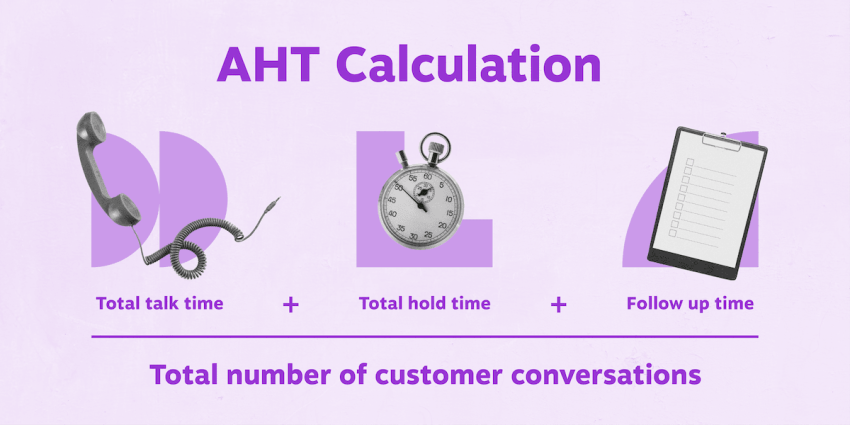
AHT calculation example
Let’s say you had 10 phone calls for the day and spent 50 minutes talking, five minutes on hold, and five minutes adding notes in your CRM.
So the formula for the average length of your calls works out like this:
[50 mins + 5 mins + 5 mins ] / 10 calls = 6 minutes AHT
Once you’ve calculated your average handle time, you can use the figure to optimize staffing. You can forecast the headcount you need if you know the average amount of time to help each customer.
Then when you know your call volume and average handling time, you can enter these figures into an Erlang calculator:
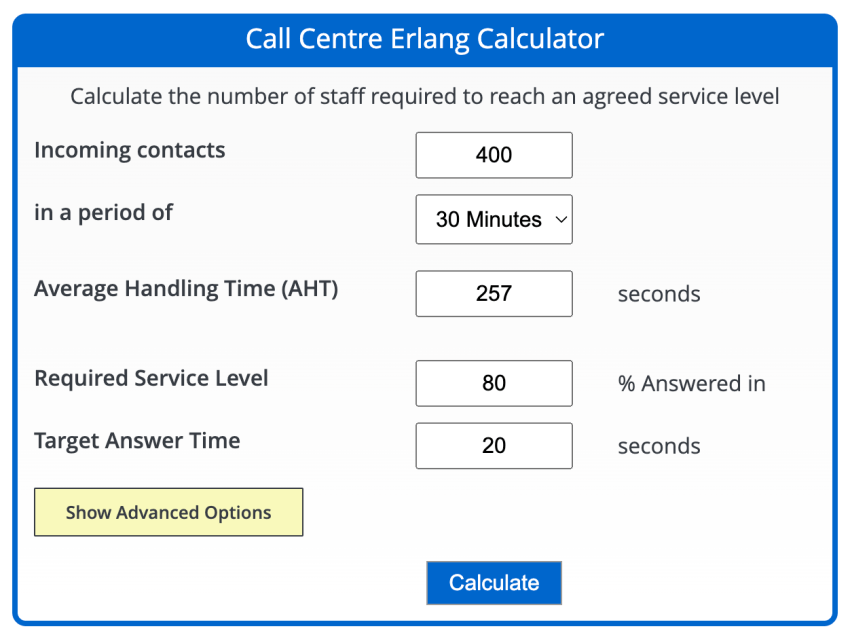
The Erlang calculator finds the best number of staff for a contact center at any given time. Supervisors use this to predict the ideal number of agents for peak periods so the customer experience remains at its best.
What Is a Good Average Handle Time?
Six minutes is considered a good average handle time across industries:
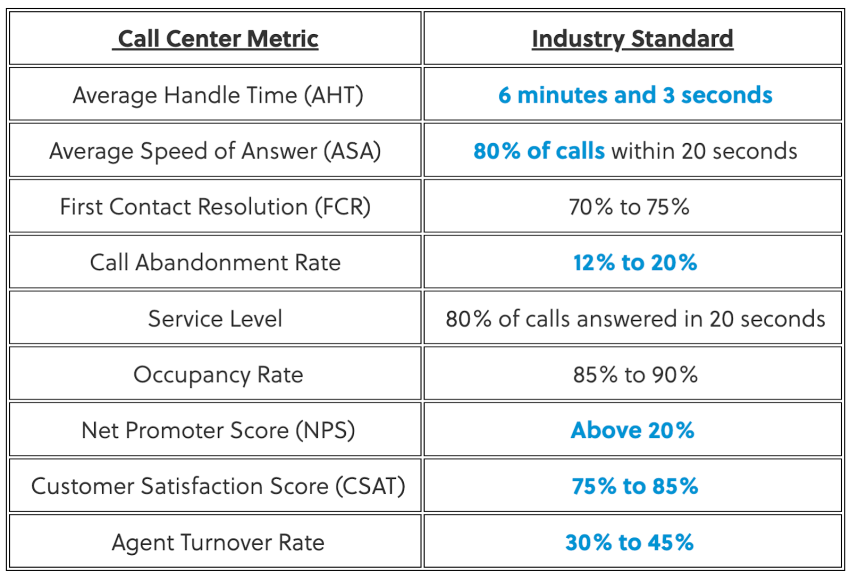
But remember, there’s no universal “good” average handle time that applies to all call centers.
The optimal average handle time depends on various factors, such as the type of call center (inbound, outbound), simple queries vs. complex technical support, call types (sales calls, billing questions), and agent performance (experienced vs. new hires).
Setting the target AHT should factor in call type distribution and complexity to have realistic expectations.
AHT Industry Benchmarks
One recommendation by DeAnna Kerley, Customer Success Manager at Kustomer, is to lay out AHTs per service type. She suggested the following handle times for these call centers. The average handle time across these services is 6.73 minutes:
| Service Type | Average Handling Time (Minutes) |
|---|---|
| Delivery | 4.45 |
| Marketplace | 7.5 |
| Retail | 6.25 |
| Services | 8.7 |
Another report by Cornell University tracks AHT by company size and sector. The average of these industries is 6.46 minutes:
| Sector & Company Size | Average Handling Time (Minutes) |
|---|---|
| Large Business | 8.7 |
| Telecommunications | 8.8 |
| Retail | 5.4 |
| Business & IT Services | 4.7 |
| Financial Services | 4.7 |
If we accept around six minutes as the industry standard, is it a good AHT? When delivery teams are averaging under four and a half minutes, it’s easy to expect the same from your other units.
Of course, your business may already be performing at a lower AHT. Does this mean you should make an effort to lengthen the time for calls handled?
You can only determine a good figure in conjunction with Net Promoter Score (NPS) and Customer Satisfaction score (CSAT). NPS measures how willing your customer is to recommend your product or service. CSAT measures how satisfied your customer is with your product or service.

Once you’ve got your AHT metrics and customer feedback, decide whether you’re spending too much time with customers.
Common Mistakes When Managing AHT
For customer service operations, understanding and optimizing average handle time is important. Problems arise, however, when focusing on this metric too much. It can impact both service quality and support team dynamics.
Here’s a closer look at some of the common challenges and how they might affect your operations:
- Overemphasis on Speed: Prioritizing AHT over quality can lead to rushed conversations, decreased customer satisfaction, and unresolved issues.
- Inconsistent Measurements: Without a formula to calculate average handle time, measurements can be inconsistent and thus affect reliability.
- Agent Morale: An intense focus on reducing AHT can pressure agents, potentially leading to burnout and affecting the support team’s morale.
- Neglecting Complex Issues: AHT does not account for the complexity of certain customer calls, potentially skewing performance assessments.
- Lack of Training: Without proper access to an internal knowledge base or training, agents may struggle to improve their talking time and resolution efficiency.
Balancing efficiency with quality and providing comprehensive training and resources are key to addressing these challenges.
Let’s take a deeper look at how to improve your AHT.
How Contact Centers Can Improve Average Handle Time
You can use many tools and techniques to improve AHT. A short average handle time often correlates with high NPS and CSAT but doesn’t necessarily result in more profitable customers.
Follow these five tactics to decrease average call handling times and improve your customer experience.
1) Offer specialized agent training
When a new agent starts, what do they do in their first week? If they only receive generic workplace training, you could hurt your handle times on day one.
Specialized agent training lets you tailor your customer service function around select inbound inquiries or customer segments.
Document all your products and segments in an internal knowledge base, and then note how many staff specialize in these areas. Next, conduct a gap analysis to identify which areas need more resources.
When you train agents this way, you can apply skills-based call routing to your queues. Customers then choose their topic and get routed to the best agent to solve their issue.
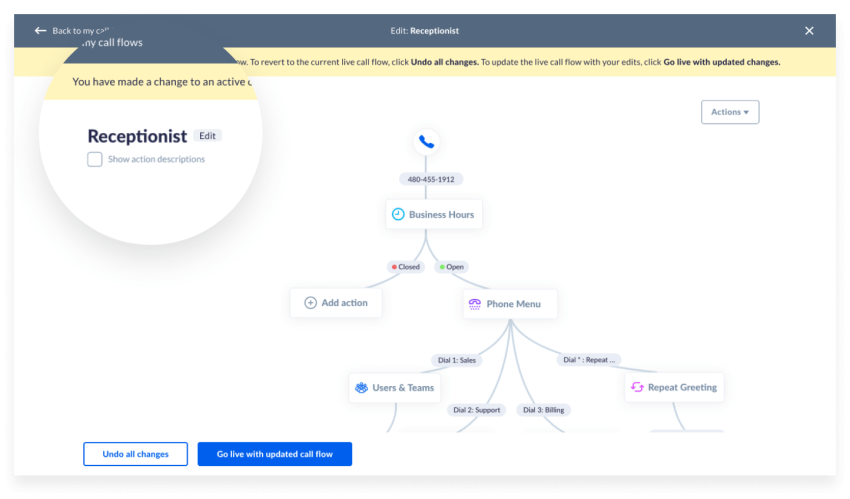
2) Assign high AHT agents a low AHT buddy
Training shouldn’t end at the end of your onboarding process. Identify successful agents with low AHT and pair them with an agent with a high AHT.
Working in real-time next to an agent means the low AHT agent can document and provide tips to avoid unnecessary delays.
These might be standard contact center practices or personal habits they can share with your wider team. Perhaps there are macros and shortcuts available to speed up after-call work (ACW) tasks.
If your resource doesn’t allow for buddying up in real-time, you can use call recording to apply the same process after the call.
3) Record calls and live monitor agents
A staple of any call center is access to recorded phone calls and speech analytics. Let supervisors or agents with shorter handle times listen to calls from those with a high AHT. This function can uncover triggers and behaviors that result in unnecessarily long calls.
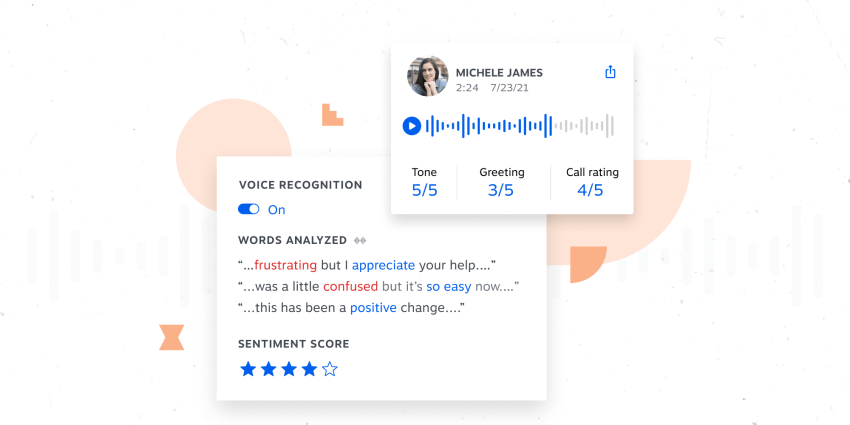
Call recording is a great feature to determine if agents adhere to call center best practices and to uncover the causes of high call times.
When you listen to a call, document how agents can improve the customer experience. Is your team forgetting to acknowledge a high wait time? Identify if there are gaps in product knowledge or having to find the right place to enter information.
Go a step further and monitor your agents in real time. While it might sound creepy, live monitoring is interruption-free for both the customer and the agent.
When supervisors have access to in-progress calls, they know what is happening in the heat of the moment. If an agent needs help, they can use advanced features like Whisper to coach the agent or Barge-In to take over the call. Intervention here helps the agent for future calls.
4) Use self-service and automation tools
Part of your extended interaction times could be time spent transferring customers to the correct department. This overhead can add unnecessary minutes to the average handling time of your customer.
A big part of optimizing AHT involves streamlining information access and workflows to improve first-call resolution time.
While it’s easy to blame a customer for not selecting the right option, tools like interactive voice response (IVR) help customers pick the right option and remove unneeded call transfers.
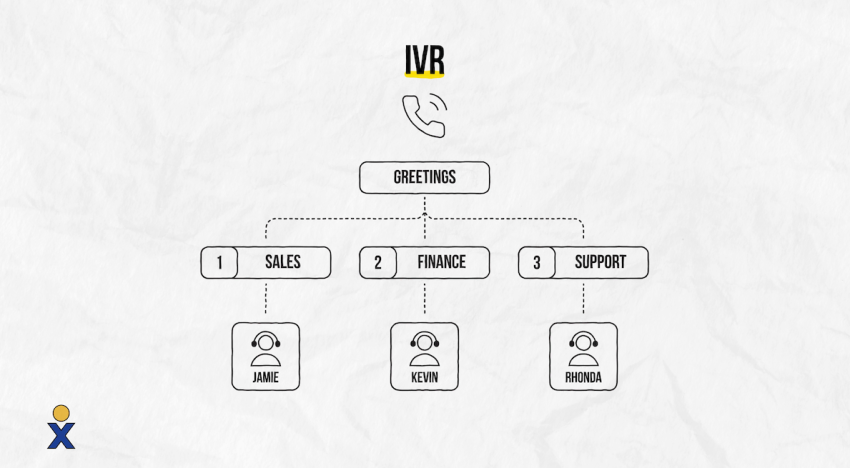
Your AHT may also include “short call outliers.” These are common questions with short answers that customers call in to get a quick response. Consider adding things like business hours and how to pay invoices to your IVR.
The result? A more accurate AHT and a better customer experience.
5) Invest in employee experience
While the customer experience is crucial in any call center, the employee experience is paramount.
Disengaged employees pass on their negativity to customers — and average hold time can surge in just a matter of minutes. Pay attention to your call queues so the overall service level stays in check.
Make sure your scorecards and displays are beneficial for agents. In some cases, the added pressure of being an underperformer is a burden rather than encouragement.
Rather than displaying a league table based on talking time, try gamification to motivate employees.
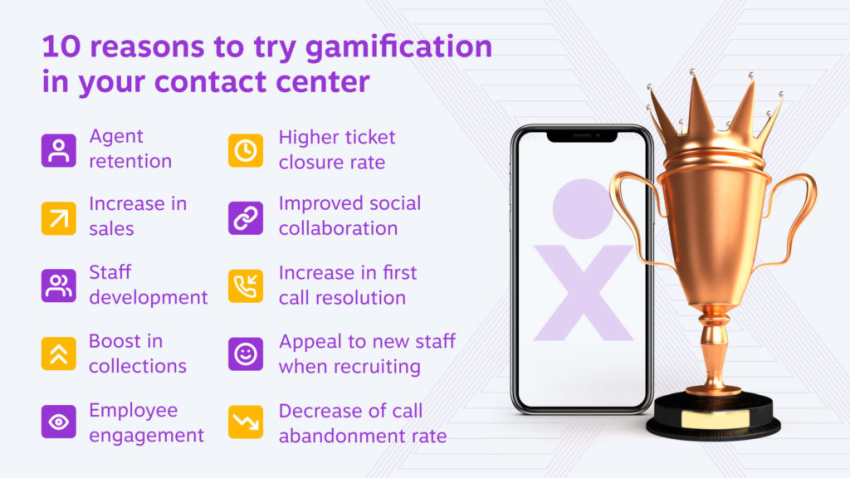
Striking the Right Balance Between AHT and Efficiency
All the above tools and techniques should form part of a comprehensive customer experience strategy. Prioritizing AHT improvement starts with a plan that’s specific and measurable.
Rather than as standalone call center metrics, leaders should AHT to drive improvements in their processes. For instance, high call times can be avoided with in-depth articles published regularly on a knowledge base.
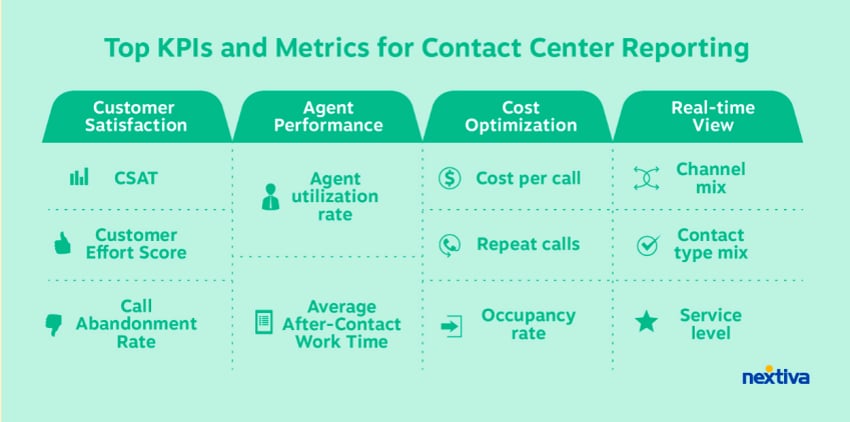
As your business takes a closer look at AHT, it’s essential to use a defined formula consistent with contact center industry best practices.
“There is a trend in customer experience where metrics like average handle time are becoming less important in isolation. There is now a trend toward using a more holistic approach when measuring CSAT. By using a combination of different metrics, like average handle time, a business can analyze its genuine CSAT. They can measure this with broader indicators like Net Promoter Score (NPS) — but AHT remains a key indicator as processes get revamped.”
~Patrick Watson, Senior Analyst, Cavell Group
Rather than firefighting and trying quick fixes, contact centers must plan for the future. Otherwise, you’ll end up in the same position six months later and have to revisit the amount of time people spend on the phone.
When documenting your plan, include these five tools and techniques. But, also spend time assigning an owner and a delivery date.
Remember, a plan without benchmarks and dates is a plan doomed to fail.
Make sure you have the right communications platform that call center agents and supervisors enjoy.
When businesses adopt a cloud-based contact center, they exert more control over their calls and customer experience.
Your complete call center solution.
See why top brands use Nextiva to handle calls at scale. Easy to use. Fast setup.
Average Handle Time FAQs
A good average handle time (AHT) is one that efficiently balances between speed and quality of customer calls service. It varies across industries but aims for the shortest duration that resolves calls effectively, boosting customer satisfaction without rushing the process.
To calculate the average hold time, add the total hold time for all calls within a specified period, then divide by the number of calls handled. This metric is crucial for assessing the efficiency of your support team.
Average time analysis involves examining AHT data to identify trends, assess support team performance, and find ways to improve customer satisfaction. It can highlight areas for training or adjustments in the internal knowledge base.
The AHT measurement quantifies the average duration of customer calls, including talk time, hold time, and after-call work. The average handle time formula is:

















 Customer Experience
Customer Experience 









